
Wahlenbergia gloriosa, commonly known as royal bluebell is a perennial herb in the bluebell family Campanulaceae. It has egg-shaped leaves near the base of its stem, linear leaves higher up and usually a single purple flower with a tube-shaped base. The flower is the floral emblem of the Australian Capital Territory.

Ballota nigra, black horehound, is a perennial herb of the family Lamiaceae. It is native to the Mediterranean region and to central Asia and it can be found throughout Europe. It is also naturalized in Argentina, New Zealand, and the Eastern United States. It blooms in the Northern Hemisphere from May to August.

Catalpa bignonioides is a species of Catalpa that is native to the southeastern United States in Alabama, Florida, Georgia, Louisiana, and Mississippi. Common names include southern catalpa, cigartree, and Indian-bean-tree. It is commonly used as a garden and street tree.
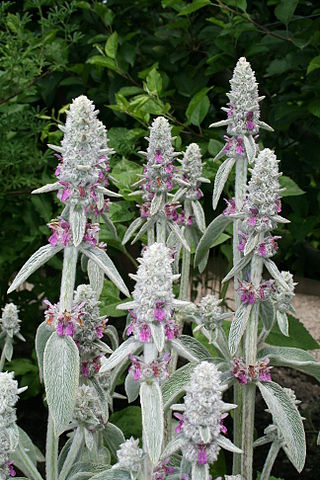
Stachys byzantina, the lamb's-ear or woolly hedgenettle, is a species of flowering plant in the mint family Lamiaceae, native to Armenia, Iran, and Turkey. It is cultivated over much of the temperate world as an ornamental plant, and is naturalised in some locations as an escapee from gardens. Plants are very often found under the synonym Stachys lanata or Stachys olympica.
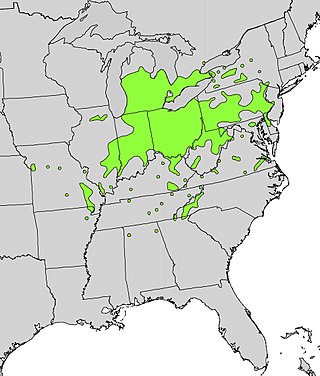
Malus coronaria, also known by the names sweet crabapple or garland crab, is a North American species of Malus (crabapple).
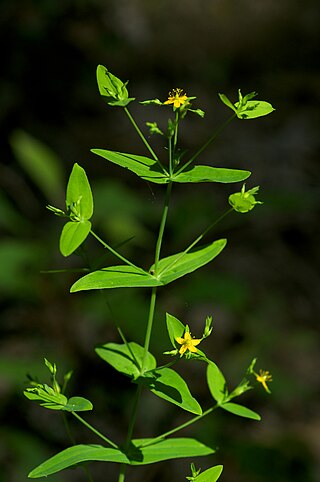
Hypericum mutilum is a species of St. John's wort known by the common name dwarf St. John's wort. It is native to parts of North America and is present in other parts as an introduced species. It is an annual or perennial herb taking a multibranched erect form up to about 60 centimeters tall. The oval green leaves are one or two centimeters long and are covered in tiny glands. The inflorescence is a compound cyme of tiny flowers. H. mutilum subsp. mutilum and subsp. boreale have a diploid number of 16, and H. mutilum subsp. boreale can have a diploid number of 18.

Lindernia dubia is a species of flowering plant known by the common names yellowseed false pimpernel and moist bank pimpernel. It is a member of the "new" plant family Linderniaceae, and it is sometimes treated as a member of the families Scrophulariaceae and Plantaginaceae. It is native to much of the Americas from Canada to Chile, and it can be found on other continents as an introduced species. It grows in wet habitat, such as riverbanks, pond margins, and meadows. It is an annual herb growing a mostly erect, branching stem to exceed 30 centimeters in height. The oppositely arranged leaves vary in size and shape, from lance-shaped to oval, toothed or not, and under one to over three centimeters long. Flowers emerge from upper leaf axils. Each has a calyx of five narrow, linear sepals. The tubular corolla is up to a centimeter long, white in color with a blue or purple tint, and lipped at the mouth, the lower lip with three rounded lobes. The fruit is a capsule containing yellow seeds.

Scaevola ramosissima, commonly known as the purple fan-flower or snake flower is a flowering plant in the family Goodeniaceae and is endemic to south eastern Australia. It has wiry, horizontal branches and purple fan-shaped flowers.
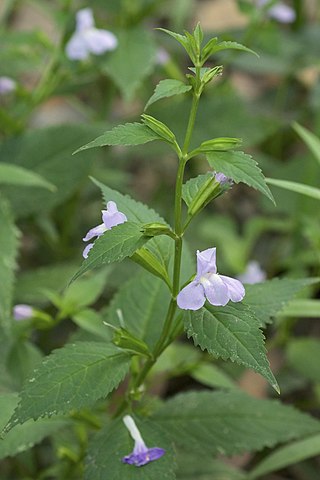
Mimulus alatus, the sharpwing monkeyflower, is an herbaceous eudicot perennial that has no floral scent. It is native to North America and its blooming season is from June to September. The flowering plant has green foliage and blue to violet flowers. It has a short life span compared to most other plants and a rapid growth rate. Like other monkey-flowers of the genus Mimulus, M. alatus grows best in wet to moist conditions and has a bilabiate corolla, meaning it is two-lipped. The arrangement of the upper and lower lip petals suggests a monkey’s face. The winged stems together with the monkey face give the plant its common name.
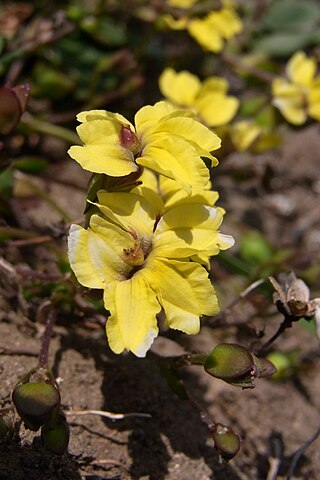
Goodenia paniculata, commonly known as branched goodenia, is a species of plant in the family Goodeniaceae and is endemic to eastern Australia. It is a short-lived herb with egg-shaped to lance-shaped leaves with toothed edges and racemes of yellow flowers.

Karomia speciosa is an African deciduous large shrub or bushy tree up to 7 m, and relocated to the family Lamiaceae from Verbenaceae. It is one of 9 species in the genus Karomia, a genus containing species previously classified in Holmskioldia, and is closely related to Clerodendrum. The only remaining species in the genus is Holmskioldia sanguinea, occurring in the foothills of the Himalayas.
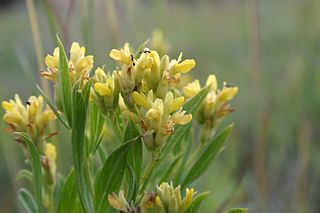
Pearsonia cajanifolia is a South African shrublet belonging to the family of Fabaceae, and one of 13 species in the genus, usually herbs or shrublets with woody rootstocks and all occurring in Africa south of the equator with the exception of 1 species found on Madagascar. P. cajanifolia is commonly found in submontane grassland, at altitudes 1350–2100 m, in the South African provinces of Free State, Gauteng, Limpopo, Mpumalanga, and North West, also in Zimbabwe and Malawi.

Chaenorhinum origanifolium is a species of flowering plant in the family Plantaginaceae. It is native to mountainous regions of the Iberian Peninsula and the Balearic Islands. It grows on rocks and crevices of escarpments, usually in limestone cliffs.

Prostanthera tysoniana is a species of flowering plant in the family Lamiaceae and is endemic to Western Australia. It is a small, intricately-branched shrub with broadly elliptic leaves arranged in opposite pairs and white or cream-coloured flowers with purple streaks.

Jovellana sinclairii, commonly known as the New Zealand calceolaria, is an endemic New Zealand shrub found in eastern and central North Island forests. In the family Calceolariaceae, it has white, bell shaped flowers with spots of purple on the inside.

Prostanthera megacalyx is a species of flowering plant in the family Lamiaceae and is endemic to Queensland. It is a small shrub with pale green leaves and mauve flowers.
Plectranthus purpuratus or cliff spurflower is a species of flowering plant in the family Lamiaceae, native to South Africa's Kwazulu-Natal and Mpumalanga provinces, as well as eSwatini. The name is frequently misapplied to Plectranthus ciliatus, presumably because both have purple-backed leaves.
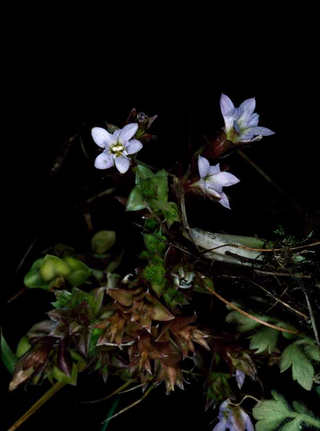
Gentiana baeuerlenii is a flowering plant in the family Gentianaceae and is endemic to New South Wales. It is a small annual herb with whitish-blue flowers.
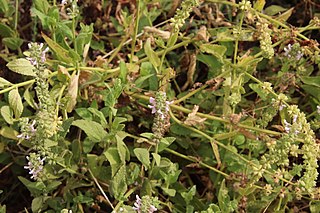
Stachys stebbinsii is a species of perennial herb in the mint family commonly known as Stebbins' hedgenettle. This plant is characterized by a musky aroma, flowers with large lower lips, and glandular hairs that densely cover the stems. S. stebbinsii is native to California and northwestern Baja California. It is usually found growing in moist places in a wide variety of habitats including disturbed areas, chaparral, coastal sage scrub and mountains.
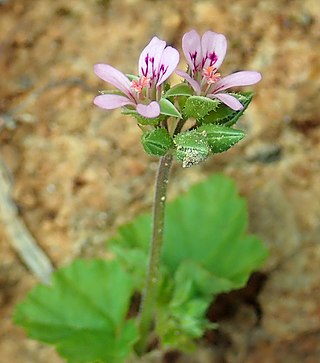
Pelargonium inodorum, commonly known as wild pelargonium, is a flowering plant in the family Geraniaceae. It is grows in New South Wales, Queensland, Tasmania, Victoria, New Zealand. It has scented leaves and mostly pink flowers.



















